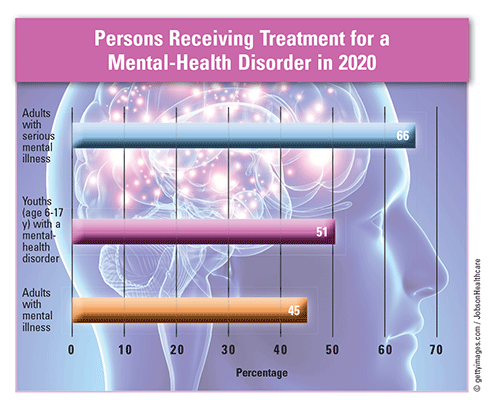US Pharm. 2022;47(5):14.
Based on CDC data for 2019, the National Alliance on Mental Illness notes that mental-health disorders were diagnosed in 21% of adult patients mainly during physician office visits. About 19.2% of diagnosed patients received treatment.

Receipt of Treatment: In 2019, 19.2% of adult patients had received any mental-health treatment in the past 12 months; 15.8% took prescription drugs for their mental-health condition and 9.5% received counseling/therapy from a mental-health professional. In 2020, 66% of adults with serious mental illness received treatment for their condition, whereas a smaller proportion (45%) of adults with any mental illness received treatment. Patients had a mean delay of 11 years between the onset of symptoms and receipt of treatment. In 2020, 15.8% of adult patients were taking prescription drugs and 9.5% received counseling/therapy from a mental-health professional.
Disparities in Treatment: In 2019, 18.5% of patients aged 18 to 44 years, 20.2% of those aged 45 to 64 years, and 19.4% of those aged 65 years and older received any mental-health treatment, took medication, or received counseling/therapy from a mental-health professional. The prevalence of counseling/therapy declined with age progression, with rates of 11.6% in patients aged 18 to 44 years, 9.1% in those aged 45 to 64 years, and 5.7% in those aged 65 years and older. Women were more likely than men (24.7% vs. 13.4%) to have received any mental-health treatment. The number of women taking medication was nearly double that of men (20.6% vs. 10.7%), and 62.5% more women than men (11.7% vs. 7.2%) received counseling/therapy. Non-Hispanic white adults (23.0%) were more likely than non-Hispanic black (13.6%) and Hispanic adults (12.9%) to have received any mental-health treatment. Among adult patients who received counseling/therapy from a mental-health professional, 10.9%, 8.1%, and 6.6% were non-Hispanic white, non-Hispanic black, and Hispanic, respectively. Taking medication for mental illness was most common among non-Hispanic white adults (19.1%), followed by non-Hispanic black (11.1%) and Hispanic adults (10.3%).
Place of Residence: Twenty percent more adults living in rural areas received mental-health treatment, compared with adults in large metropolitan areas (21.5% vs. 17.9%). Similarly, 33% more adult patients living in nonmetropolitan areas took medications prescribed by a mental-health professional, compared with those in metropolitan areas (18.9% vs. 14.2%). However, the trend was reversed with respect to counseling/therapy by a mental-health professional: 24% fewer adults living in rural areas received counseling/therapy, compared with adults in large metropolitan areas (7.8% vs. 9.7%).
The content contained in this article is for informational purposes only. The content is not intended to be a substitute for professional advice. Reliance on any information provided in this article is solely at your own risk.
To comment on this article, contact rdavidson@uspharmacist.com.





